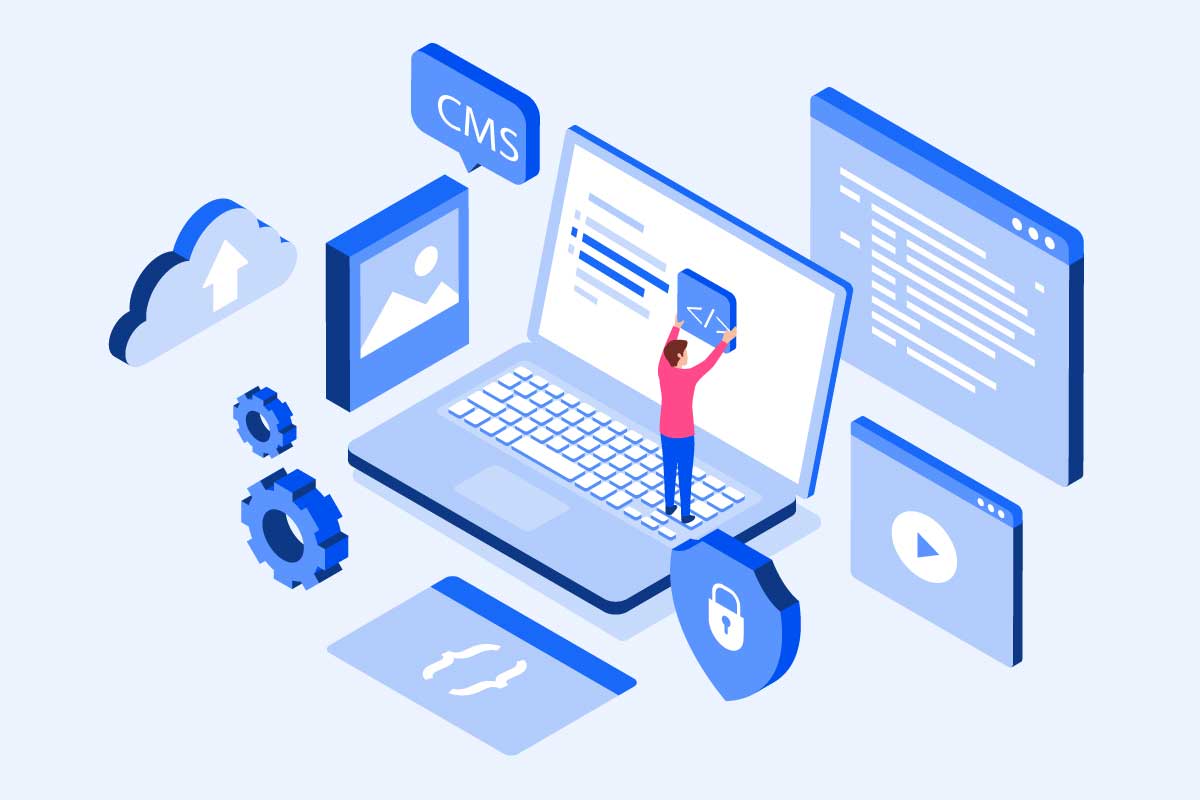In today’s digital age, online presence isn’t just an option; it’s an absolute necessity. Whether you’re a business owner, a blogger, or someone looking to share their ideas with the world, you need a platform to connect with your audience meaningfully. This is where understanding the website design and development process becomes essential.
A well-designed, functional, and user-friendly website is at the heart of a successful online presence. Crafting such a website requires a thorough understanding of what is the web design process, as well as an in-depth knowledge of the website development process. It’s about seamlessly integrating aesthetics with functionality to create an engaging and interactive user experience.
WordPress, a popular platform known for its versatility and user-friendly interface, plays a crucial role in website design and development. It offers robust tools that simplify and streamline both the WordPress website design and WordPress website development processes. From small personal blogs to large e-commerce sites, WordPress serves as a one-stop solution, offering a wide array of customizable options to meet every user’s unique needs.
In the following sections, we’ll delve deeper into the phases of the Web Process in the context of WordPress, providing a clear and detailed overview of the comprehensive website design and development process. We aim to offer valuable insights whether you’re a professional web developer, a business owner seeking to understand the process, or simply someone curious about how WordPress websites come to life.
Table of Contents
II. What is WordPress Web Design Process?
The WordPress website design process is a multi-stage method used to create visually appealing, intuitive, and user-friendly websites using the WordPress platform. But, it’s not just about making a website look attractive. Rather, it’s a strategic process of planning, creating, and arranging the elements on a website to ensure an engaging and seamless user experience.
WordPress website design is paramount in creating interactive, user-friendly, and aesthetically pleasing websites. It allows designers to craft an online environment where users can interact and engage with the content effortlessly, improving user experience and satisfaction. As we all know, a well-designed website can help enhance a brand’s online presence, improve credibility, and even drive business growth.
WordPress, as a powerful web design platform, offers its users immense flexibility and a wide range of design options. It provides thousands of customizable themes and plugins that allow designers to create unique and personalized website layouts. Additionally, WordPress supports multimedia integration, enhancing the website’s visual appeal and interactivity. Its user-friendly interface also allows those without extensive coding knowledge to manage and tweak the design of their website, further broadening its appeal.
This flexibility and range make the WordPress website design process integral to the overall website design and development process. Whether you’re a novice blogger, a small business owner, or a large corporation, understanding the web design process can equip you with the knowledge and best WordPress tools to create a website that truly stands out.
In the following section, we will delve deeper into the phases of the Web Process and explore each step involved in the WordPress web design journey.
III. A Quick WordPress Web Design & Development Process Overview
The journey from conceptualization to the final launch of a WordPress website involves a series of steps, each crucial to creating a robust, functional, and user-friendly platform. This journey, known as the WordPress website design and development process, integrates design principles, technology, and content strategy, creating a seamless user experience.
Initially, the process begins with the WordPress website design stage. This phase involves understanding the project’s goals, target audience, and market trends. It also includes Wireframing, creating design concepts, and getting them approved before developing a working model or prototype. The design phase aims to create a visually pleasing and intuitive interface that aligns with the brand’s identity and caters to the target audience’s preferences.
The design phase then transitions into the WordPress website development stage. Here, the approved designs are transformed into a functioning website. This phase involves coding, creating custom themes, setting up the WordPress CMS, testing, and launching the website. Post-launch, the site is continually monitored for performance, with updates and WordPress maintenance tasks carried out as necessary.
Understanding this website design and development process is essential for developers and clients. For developers, this process provides a structured approach, ensuring every aspect of the website is given due attention and nothing is overlooked. It allows for efficient project management, better resource allocation, and higher-quality outputs.
For clients, understanding the phases of the Web Process helps set realistic expectations and facilitates better communication with the development team. It also enables clients to provide valuable input at various stages, ensuring the final product aligns perfectly with their vision and business goals.
IV. Phases of WordPress Web Design Process
The WordPress website design phase is crucial to the website design and development process. It involves several key steps, each contributing to creating an engaging and effective website.
Discovery & Research: This is the first and one of the most critical phases of the WordPress website design process. It involves understanding the project’s scope, the client’s goals, and the target audience’s needs. Thorough market research is also conducted to identify competitors and understand industry trends. This phase lays the foundation for the design process and helps align the design with the client’s vision and business objectives.
Wireframing: Once the project’s scope is understood, the next step is Wireframing. This phase involves creating a visual guide or blueprint that represents the skeletal framework of the website. Wireframes provide a clear layout of the site’s structure, including the placement of the elements, the navigation system, and how the site will work. Wireframing is essential in visualizing the site’s functionality and paving the way for the actual design process.
Designing: The design phase is where the actual WordPress website design occurs. Designers craft the visual look and feel of the website, incorporating color schemes, typography, images, animations, and other design elements. They also ensure the design is responsive, i.e., it adapts to different screen sizes and devices. The design should be visually appealing, user-friendly, and in sync with the brand’s identity.
Review & Approval: After the design is ready, it is presented to the client for review. This stage is crucial for gathering feedback and making necessary revisions to the design. It ensures that the design meets client expectations and aligns with business goals. Once the client approves the design, the process moves to the next phase.
Prototype & Mockup: In this phase, a working model or prototype of the website is created to give an idea of the design and functionality. This allows the client and the design team to experience the website’s look and feel before moving to the development phase. It’s an opportunity to make any final adjustments to the design and ensure it’s ready for the next step: The WordPress website development process.
Each phase is interconnected, each contributing to an overall goal: to create a well-designed, user-centric WordPress website that helps achieve the client’s business objectives.
V. What is WordPress Web Development Process
The WordPress Web Development Process is a systematic procedure that involves taking the approved website design and transforming it into a fully functioning website. While the WordPress website design phase focuses on the aesthetics and user interface of the site, the WordPress website development stage delves into the mechanics behind the scenes, implementing functionality and performance.
WordPress Web Development goes far beyond merely implementing a design. It involves programming the website’s functionality, integrating features, and ensuring smooth performance. This process includes coding the website, creating and customizing WordPress themes, setting up databases, integrating plugins for additional functionalities, ensuring SEO optimization, and implementing security measures.
The importance of the WordPress Web Development Process in the broader website design and development process cannot be overstated. This phase brings the website design to life, enabling interaction with visitors. It ensures that the beautiful design created in the previous stages becomes a responsive, fast, and user-friendly website that performs optimally.
Moreover, the WordPress Web Development Process is crucial for maintaining the website’s health post-launch. It involves continuous monitoring, updates, and troubleshooting, ensuring the website stays current, secure, and delivers an excellent user experience.
In the following section, we will delve into the specific phases of the WordPress Web Development Process, detailing each step and its importance in the overall phases of the Web Process.
VI. Phases of WordPress Web Development Process
The WordPress Web Development Process is integral to the comprehensive website design and development process. It involves several key steps that transition a static website design into a dynamic, interactive, and user-friendly WordPress website.
Development: This phase involves translating the approved design into a functional website. It requires coding skills and an in-depth understanding of WordPress to create custom themes, install and configure plugins, and set up the WordPress Content Management System (CMS). In the development stage, the website starts to come to life, with every design element becoming interactive and functional.
Testing: After the development phase, the website undergoes rigorous testing. This step is crucial to ensure a bug-free and smooth user experience. The testing phase includes checking for coding errors, testing the website’s functionality, and assessing the site’s performance across different browsers and devices to ensure compatibility. It is also necessary to validate the website’s load time, SEO optimization, and responsiveness in this phase.
Launch: The website is ready to go live once testing is complete and any identified issues have been addressed. The launch phase involves setting the website up on the client’s server, configuring the domain, setting up email accounts, and making the website live for the public. Before launch, a final review is conducted to ensure all elements are working as expected.
Maintenance & Updates: The WordPress website development process doesn’t end with the website launch. Instead, it’s a continuous process that regularly maintains the website to ensure optimal performance. This phase involves keeping the WordPress CMS, plugins, and themes updated, routinely backing up website data, monitoring website performance, ensuring security, and making necessary changes based on user feedback or evolving business needs.
Each of these phases in the WordPress website development process plays a significant role in the successful creation, launch, and long-term health of a WordPress website. Together, they form the core of the broader Phases of the Web Process and ensure a robust, secure, and high-performing website that effectively serves the client’s needs and the end user’s expectations.
VII. Conclusion
The WordPress website design and development process is a structured pathway that transitions a concept into a fully functioning, visually appealing, and user-friendly website. It includes various integral phases of the Web Process that work in tandem to ensure a site that looks good, performs efficiently, and meets the target audience’s needs.
Following these phases can lead to successful website development that ticks all the right boxes, from design to functionality. For businesses, understanding these phases can facilitate better communication with developers and realistic expectation setting.
Whether planning to embark on a DIY WordPress project or considering professional web development services, these processes are worth understanding. As a professional web design and development company in Minneapolis, Watermark Design is committed to delivering top-notch WordPress websites that align with your business goals and target audience needs. We diligently follow the WordPress website design and development process to ensure a robust, secure, and user-friendly website that amplifies your online presence.
In conclusion, creating a WordPress website may seem complex, but following these established processes and phases allows you to navigate the path more easily. And remember, whether you’re seeking advice, need professional help, or want a comprehensive website solution, Contact Watermark Design to assist you every step.



0 Comments